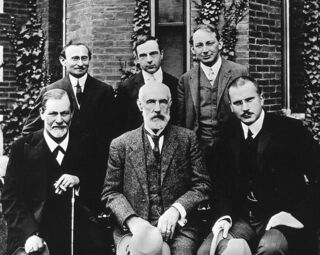Synchronicity
How Synchronicity Can Assist the Psychotherapeutic Process
Synchronicities increase during life stressors.
Posted October 3, 2022 Reviewed by Michelle Quirk
Key points
- Psychotherapy proceeds in stages: engagement, pattern search, change, and termination.
- Synchronicity may facilitate reaching for the goals of each stage.
- Therapists need to be able to recognize meaningful coincidences in order to utilize them.

What is psychotherapy? Adjectives proliferate like cognitive, behavioral, cognitive-behavioral, psychodynamic, psychoanalytic, DBT, client-centered, and hundreds more. What does the noun psychotherapy mean?
Psychotherapy is a process that can be divided into stages: engagement, pattern search, change, and termination (Beitman & Yue, 2004). Synchronicity can facilitate the achievement of these subgoals of therapy no matter what type of therapy,
Research shows that synchronicity can aid the therapeutic process but therapists need to be able to recognize an occurring meaningful coincidence, so that it can be utilized as a beneficial factor. (Roesler & Reefschläger, 2022).
Engagement
Tarnas described “fated meetings” in which the initial interview reveals that the patient’s past history mirrors the past history of the therapist. This historical resonance helps to increase therapist empathy and connection without necessarily directly acknowledging it. One's problems sometimes walk into the office.
In another engagement example, a patient had not seen her ex-therapist for several years. One day the therapist was putting the patient's file in his archive, thinking about how she was doing. At night the therapist dreamt that the patient's husband told her that she could bring the therapist something because the therapy had helped. Her husband had been very negative about the therapy. The next day this woman called to make an appointment. The synchronicity strengthened the re-engagement (Roesler & Reefschläger, 2022).
Pattern Search
A young therapist was helping a young woman deal with her divorce as he was recovering from his own divorce. The similarity quickened the therapist’s understanding of her problem, utilizing careful supervision to minimize countertransference.
Initiating Change
Carl Jung’s patient described a dream involving a golden scarab. Frustrated with her lack of change, Jung went to the window and plucked a scarab-like beetle from the window and presented it to her. “Here is your scarab.” Her immutable rationality melted and therapy proceeded successfully.
Rolf Gordhamer (1997) was counseling an Iranian college student, who was very worried about his family. They had to leave their home, which was in the war zone. He searched for a way to ease his emotional pain. Thinking he could bring some spiritual essence into the sessions, the therapist showed him the book Autobiography of a Yogi. The client reached into his satchel and pulled out the same book. They were both almost on the same page. This synchronicity calmed the client who now felt that destiny was controlled by an essence greater than ourselves.
Maintaining Change
Kelly, a 28-eight-year-old member of Alcoholics Anonymous, was struggling with anger and resentment focused on her father, an active alcoholic, from whom she was estranged. One day, as she was reading Alcoholics Anonymous Big Book, she came across a passage that described alcoholics as sick people who, like cancer patients, should not be treated with disdain and resentment. She suddenly had a “revelation” about her father and felt her anger and resentment melt into empathy and concern. She realized how he was suffering from his alcoholism, just as she had been suffering from the same illness: “I felt like all those feelings that I carried around about my dad were gone. I guess I see this now as God removing my resentments.”
She suddenly “felt a sense of peace.” As she pondered these new feelings and perceptions, her cell phone rang; it was her father calling. The two had been so alienated that she didn’t think he knew her phone number. Surprisingly, he confessed to her how important she had been in his life, how sorry he was, and how he cared about her and would do anything to help her. He wept as he spoke openly about their troubled relationship. The synchronicity confirmed her changed attitude toward him (Cameron, 2004).
A grandfather of two was struggling with his long-standing “catastrophizing.” If there was any possibility of something going wrong, he quickly went to the worst outcome and stayed there.
In therapy with me, he admitted that he needed to keep the worrying going because he believed that his worry kept the bad things from happening. He was not praying to God but to some unnamed angel that he thought required him to worry as a form of worship. In speaking this belief in the angel out loud, he more clearly saw its superstitious nature and questioned the practice. A few days later, his daughter-in-law gave birth to an infant with a high bilirubin. He knew that the outcome was likely to be positive because when his son was born he too had a high bilirubin and was successfully treated by light therapy. He recognized that he did not need to worry because the angel was superstition and the outcome in the past was positive. The high bilirubin in his grandson became a serendipitous opportunity to practice what he had just learned (Beitman, 2022).
The Decision to Not Change
My patient Bart was heading for divorce. He and his wife kept arguing. They could find no resolution, and couples therapy did little good. As he obsessed about divorce in and out of therapy, Bart went to the local mall and saw five friends and acquaintances, each of whom just happened to be unhappily in the midst of divorce. Several weeks later he independently heard from three old friends, each of whom were divorced and struggling. This series of divorcing and divorced people made him realize that he did not want to be one of them. The couple stayed together and left town for new jobs. I never knew if this turned out to be a good decision.
Comment
As meaningful coincidences become more accepted, therapists will recognize that psychotherapy and counseling are fertile grounds for synchronicities that can aid the psychotherapeutic process. Patients can help their therapists to recognize and use these events by expecting them to happen and reporting them.
References
Beitman, B & Yue, D. (2004) Learning Psychotherapy. New York: WW Norton.
Roesler, C., & Reefschläger, G. I. (2022). Jungian psychotherapy, spirituality, and synchronicity: Theory, applications, and evidence base. Psychotherapy, 59(3), 339–350. https://doi.org/10.1037/pst0000402
Rolf Gordhamer, “Destiny,” in Coincidence or Destiny? Stories of Synchronicity that Illuminate Our Lives by Phil Cousineau and Robert A. Johnson (York Beach, ME: Conari Press, 1997), 203–4.
Cameron, MA. Synchronicity and spiritual development in alcoholics anonymous: a phenomenological study. St. Louis, MO: St. Louis University. Unpublished dissertation,(2004)
Beitman BD (2022) Meaningful Coincidences: How and Why Synchronicity and Serendipity Happen. Rochester, VT: Park Street Press




